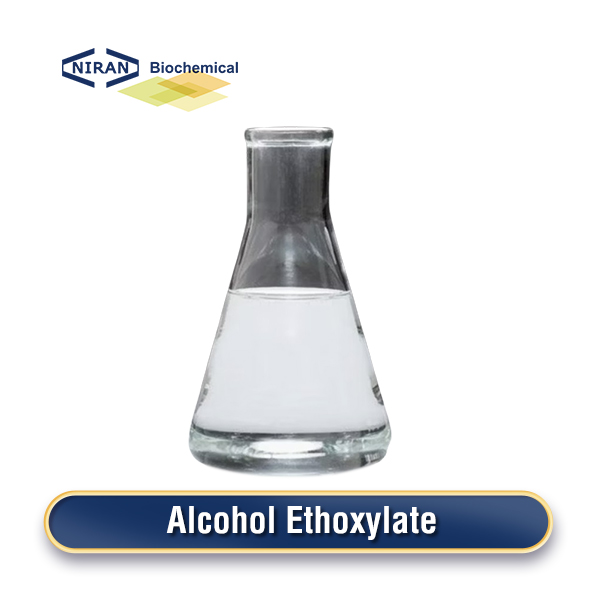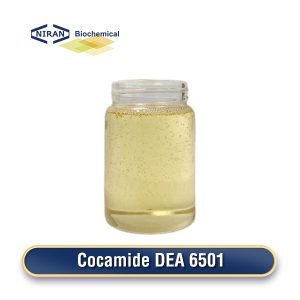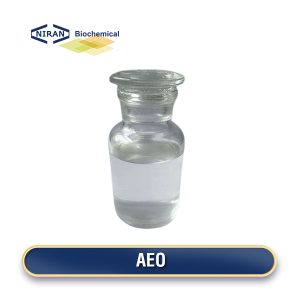Alcohol Ethoxylate
- CAS Number: 68439-46-3
- Chemical Formula: C6H14On (n = 6-12, depending on the specific ethoxylate chain length)
- MOQ: 1000KG
- Shelf Life: 2 years
- Synonyms: Ethoxylated Alcohol, Alcohol Polyethylene Glycol Ether, Fatty Alcohol Ethoxylate, Alcohol Ethoxylated
Product Description
What Is Alcohol Ethoxylate?
Alcohol Fatty alcohols can be ethoxylated to produce ethoxylate, a kind of nonionic surfactant. These surfactants are extensively utilized in many different items, such as cosmetics, cleaning supplies, and detergents. They are produced by reacting fatty alcohols (such as lauryl alcohol, cetyl alcohol, or stearyl alcohol) with ethylene oxide (EO) under alkaline conditions, typically using sodium hydroxide (NaOH) or potassium hydroxide (KOH) as catalysts.
The reaction occurs at elevated temperatures, usually between 130°C and 180°C, to facilitate the addition of ethylene oxide molecules to the alcohol molecule, forming a polyether chain. The length of the ethoxylated chain depends on the ratio of ethylene oxide to alcohol used. The product is then neutralized, purified, and distilled to remove by-products and achieve the desired characteristics.
Alcohol ethoxylates are valued for their ability to lower surface tension, improve solubility, and enhance the overall performance of the formulation in various cleaning and personal care products.
Related Parameters:
| Items | Standard |
| Appearance | Clear to slightly cloudy liquid |
| Active Matter | 60%-80% |
| pH (1% aqueous solution) | 6.0-8.0 |
| Color (APHA) | Max. 50 |
| Water Content | Max. 1.0% |
| Viscosity (cP) | 100-1000 cP |
| Free Alkali | Max. 1.0% |
| Ethylene Oxide (EO) content | 10%-30% |
Recommended Dosage of Alcohol Ethoxylate:
| Applications | Dosage |
| Surfactant in detergents | 2%-8% |
| Cleaning products | 2%-6% |
| Shampoos & Conditioners | 1%-3% |
| Personal Care Products | 1%-2% |
| Emulsifier in formulations | 1%-4% |
| Industrial Applications | 0.5%-1.5% |
| Fabric Softener | 1%-2% |
Alcohol Ethoxylate Has Wide Range of Uses:
Cleaning Products
Cleaning products for both homes and businesses frequently contain alcohol ethoxylates. They effectively remove grease and dirt while being gentle on surfaces, making them ideal for kitchen cleaners, floor cleaners, and multipurpose detergents.
Shampoos & Conditioners
In personal care, Alcohol Ethoxylates act as surfactants that help in foaming and cleansing. They remove excess oils from hair and scalp, leaving hair soft and manageable without stripping its natural moisture. Industrial Applications
In the industrial sector, Alcohol Ethoxylates are used in formulations like lubricants, emulsions, and metalworking fluids. They help in reducing surface tension, enhancing wetting, and improving the dispersion of oils and dirt.
Fabric Softeners
Alcohol Ethoxylates are also present in fabric softeners, where they improve the softness of fabrics and help reduce static cling, ensuring that clothes are comfortable and easy to wear.
Cosmetics & Personal Care
In cosmetics, they are used as emulsifiers, stabilizing oil-water mixtures in lotions, creams, and body washes, providing a smooth texture and enhancing product performance.
Textile Processing
They are used as lubricants in textile processing, improving fabric feel and reducing friction, leading to better performance during manufacturing.
User Asked Question:
Q: How does Decyl Glucoside compare to Alcohol Ethoxylate in surfactant applications?
A: Decyl Glucoside is a mild, natural surfactant commonly used in organic personal care products, providing gentle cleansing without irritating the skin. In contrast, Alcohol Ethoxylates are synthetic surfactants known for their superior emulsifying, wetting, and solubilizing properties, making them ideal for a broader range of applications, including detergents and industrial cleaners.




